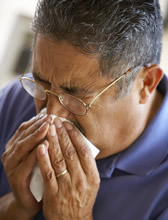Investigation: 3M Model 8000 Filtering Facepiece Respirators
Occupational Health Issues Associated with H1N1 Influenza Virus (Swine Flu)

June 29, 2010
On January 4, 2010, the California Department of Public Health (CDPH) recommended discontinued use of the model 8000 N95 respirator, manufactured by 3M Co., which the state had released to local health departments and healthcare institutions from its pandemic preparedness stockpile last October. The action came in response to reports by a California healthcare institution that in a high percentage of cases, the institution was unable to adequately fit the model 8000 N95 respirators to intended users in required fit-tests. As part of their preparedness efforts, California purchased N95 respirators, including the 3M model 8000. This model of respirator is also one of several models included in the CDC’s Strategic National Stockpile and was deployed in response to the ongoing H1N1 response to help provide protection to healthcare workers during this influenza emergency.
In a related action, on December 23, 2009, the California Department of Occupational Safety and Health (Cal/OSHA) notified the Centers for Disease Control and Prevention/National Institute for Occupational Safety and Health (CDC/NIOSH) of the CDPH experience, and requested NIOSH assistance in assessing potential causes. NIOSH began a technical investigation in response to the Cal/OSHA request. Sample 3M model 8000 respirators from two different manufacturing lots received from CDPH were used for the investigation. The investigation consisted of the following activities:
- Respirator testing conducted in accordance with existing NIOSH certification performance requirements for filter efficiency and breathing resistance.
- Visual inspection of respirators and review of quality assurance records to determine that construction and workmanship are in accordance with the NIOSH approved quality assurance plan specific to the 3M Model 8000 respirator. Review of 3M production quality assurance records (data) for both lots of respirators.
- Respirator quantitative fit testing was performed using an OSHA-accepted fit test protocol. Respirators from each lot were tested using 40 human test subjects selected from the NIOSH fit test panel. The fit test panel represented the distribution of varied facial dimensions of the US respirator user population.
- Review of published research was performed regarding fit test performance for the 3M Model 8000 respirator.
What We Know Now:
- At the request of the California Department of Industrial Relations, Division of Occupational Safety and Health (Cal-OSHA), NIOSH evaluated the performance of sample 3M Model 8000 filtering-facepiece respirators (FFRs) received from the California Department of Public Health respirator stockpile to determine whether they met NIOSH’s certification requirements.The state made the request after a large healthcare organization reported that it was unable to successfully fit test their healthcare workers with the 3M Model 8000 N95 FFR received from the California stockpile.
- The NIOSH evaluation, which included laboratory performance tests, fit tests, visual inspections, and document reviews, found no evidence of a defect in the respirators or any indication that the respirators will not achieve the expected level of protection when used in accordance with the Cal-OSHA respirator standard.
- No respirator can be guaranteed to fit 100 percent of users.Federal and Cal-OSHA state respirator standards require an assortment of models and sizes of respirators be available for selection at the time of fit testing. Due to differences in the sizes and shapes of faces in the American workforce, a variety of respirators may have to be tested to achieve a good fit for an individual worker. The experience also highlights the importance of and need to assure that multiple makes/models/sizes of respirators are acquired to provide users with a variety of respirator fit options.
NIOSH Investigation of 3M Model 8000 Filtering Facepiece Respirators
Health Hazard Evaluation Report, HETA 2010-0044-3109
For further information, please contact Christina Spring (phone: 202.245.0633, email: dsa9@cdc.gov).
